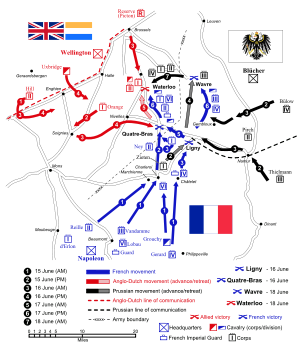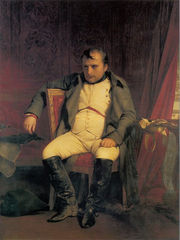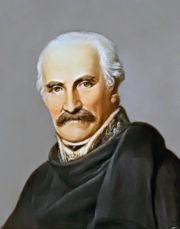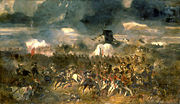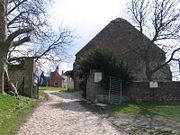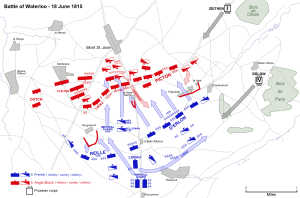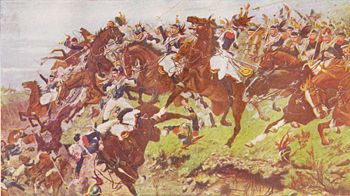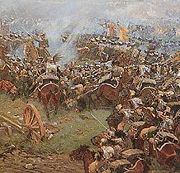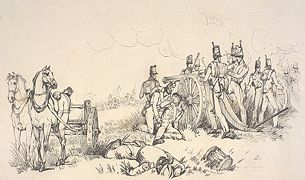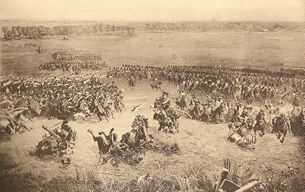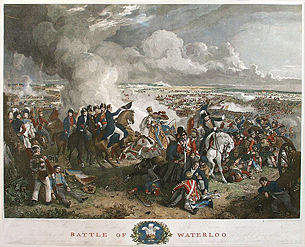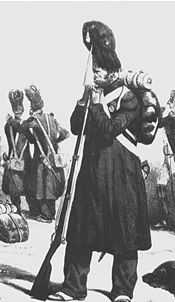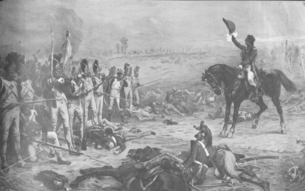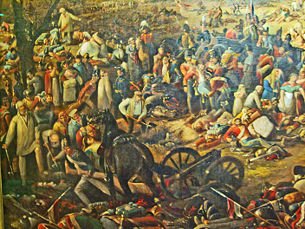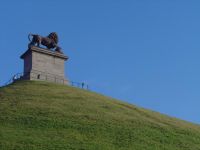Battle of Waterloo
2008/9 Schools Wikipedia Selection. Related subjects: British History
| Battle of Waterloo | |||||||
|---|---|---|---|---|---|---|---|
| Part of the Hundred Days | |||||||
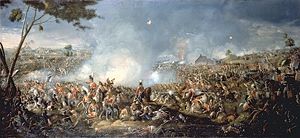 The Battle of Waterloo by William Sadler |
|||||||
|
|||||||
| Belligerents | |||||||
| Seventh Coalition: |
|||||||
| Commanders | |||||||
| Strength | |||||||
| 72,000 | Anglo-allies: 68,000 Prussians: 50,000 |
||||||
| Casualties and losses | |||||||
| 25,000 killed or wounded 7,000 captured 15,000 missing |
22,000 killed or wounded | ||||||
|
|||||
Coordinates: The Battle of Waterloo, fought near the town of Waterloo (pronounced [watəʀˈloː]) in Belgium on Sunday 18 June 1815, was the decisive battle of the Waterloo Campaign, and Napoleon Bonaparte's last. Waterloo marked the end of the period known as the Hundred Days, which began in March 1815 after Napoleon's return from Elba, where he had been exiled after his defeat and abdication the previous year. The defeat at Waterloo put a final end to Napoleon's rule as Emperor of the French.
After Napoleon returned to power in 1815, many states which had previously resisted his rule formed the Seventh Coalition and began to mobilise armies to oppose him. The first two assembled close to the northeastern border of France. They consisted of a Prussian army under the command of Gebhard von Blücher, and an Anglo-Allied army under the command of the Duke of Wellington. Napoleon chose to attack in the hope of destroying them before they, with other members of the Seventh Coalition, could join in a coordinated invasion of France.
The campaign consisted of four major battles: Quatre Bras ( 16 June), Ligny ( 16 June), Waterloo ( 18 June), and Wavre ( 18 June– 19 June). According to the Duke of Wellington, the battle at Waterloo was "the nearest-run thing you ever saw in your life."
It rained heavily overnight on 17 June, so Napoleon delayed giving battle until noon on 18 June to allow the ground to dry. Wellington's army, positioned across the Brussels road on the Mont St Jean escarpment, withstood repeated attacks by the French, until, in the evening, the Prussians arrived in force and broke through Napoleon's right flank. At that moment, the British counter-attacked and drove the French army in disorder from the field. Pursuing Coalition forces entered France and restored Louis XVIII to the French throne. Napoleon abdicated, surrendering to the British, and was exiled to Saint Helena, where he died in 1821.
The battlefield is in present-day Belgium, about eight miles (12 km) SSE of Brussels, and about a mile (2 km) from the town of Waterloo. The site of the battlefield is today dominated by a large mound of earth, the Lion's Hillock. As this mound used earth from the battlefield itself, the original topography has not been preserved.
Prelude
On 13 March 1815, six days before Napoleon reached Paris, the powers at the Congress of Vienna declared him an outlaw. Four days later, the United Kingdom, Russia, Austria, and Prussia mobilised armies to defeat Napoleon. Napoleon knew that once his attempts at dissuading one or more of the Seventh Coalition allies from invading France had failed, his only chance of remaining in power was to attack before the Coalition mobilised. If he could destroy the existing Coalition forces south of Brussels before they were reinforced, he might be able to drive the British back to the sea and knock the Prussians out of the war.
Wellington's initial dispositions were intended to counter the threat of Napoleon enveloping the Coalition armies by moving through Mons to the south-west of Brussels. This would have cut Wellington's communications with his base at Ostend, but would have pushed his army closer to Blücher's. Napoleon manipulated Wellington's fear of this loss of his supply chain from the channel ports with false intelligence. He divided his army into a left wing commanded by Marshal Ney, a right wing commanded by Marshal Grouchy, and a reserve, which he commanded personally (although all three elements remained close enough to support one another). Crossing the frontier near Charleroi before dawn on 15 June, the French rapidly overran Coalition outposts, securing Napoleon's favoured "central position" between Wellington's and Blücher's armies.
Only very late on the night of 15 June was Wellington certain that the Charleroi attack was the main French thrust. In the early hours of 16 June, at the Duchess of Richmond's ball in Brussels, he received a dispatch from the Prince of Orange, and was shocked by the speed of Napoleon's advance. He hastily ordered his army to concentrate on Quatre Bras, where the Prince of Orange, with the brigade of Prince Bernhard of Saxe-Weimar, was holding a tenuous position against the troops of Ney's left wing. Ney's orders were to secure the crossroads of Quatre Bras, so that, if necessary, he could later swing east and reinforce Napoleon.
Napoleon moved against the concentrated Prussian army first. On 16 June, with the reserve and the right wing of the army, he attacked and defeated Blücher's Prussians at the Battle of Ligny. The Prussian centre gave way under heavy French assaults, but the flanks held their ground. Ney, meanwhile, found the crossroads of Quatre Bras lightly held by the Prince of Orange, who successfully repelled Ney's initial attacks, but was gradually driven back by overwhelming numbers of French troops. First reinforcements and then Wellington himself arrived. He took command and drove Ney back, securing the crossroads by early evening, but too late to send help to the Prussians, who were defeated at the Battle of Ligny on the same day. The Prussian defeat made Wellington's position at Quatre Bras untenable, so the next day he withdrew northwards, to a defensive position he had personally reconnoitred the previous year—the low ridge of Mont St Jean, south of the village of Waterloo and the Forest of Soignes.
The Prussian retreat from Ligny went uninterrupted, and seemingly unnoticed, by the French. The bulk of their rearguard units held their positions until about midnight, and some elements did not move out until the following morning, completely ignored by the French. Crucially, the Prussians did not retreat to the east, along their own lines of communication. Instead, they too fell back northwards—parallel to Wellington's line of march, still within supporting distance, and in communication with him throughout. The Prussians rallied on Von Bülow's IV Corps, which had not been engaged at Ligny, and was in a strong position south of Wavre.
Napoleon, with the reserves, made a late start on 17 June and joined Ney at Quatre Bras at 13:00 to attack Wellington's army, but found the position empty. The French pursued Wellington, but the result was only a brief cavalry skirmish in Genappe just as torrential rain set in for the night. Before leaving Ligny, Napoleon ordered Grouchy, commander of the right wing, to follow up the retreating Prussians with 33,000 men. A late start, uncertainty about the direction the Prussians had taken, and the vagueness of the orders given to him meant that Grouchy was too late to prevent the Prussian army reaching Wavre, from where it could march to support Wellington. By the end of 17 June, Wellington's army had arrived at its position at Waterloo, with the main body of Napoleon's army following. Blücher's army was gathering in and around Wavre, around eight miles (13 km) to the east.
Armies
Three armies were involved in the battle: Napoleon's Armée du Nord, a multinational army under Wellington, and a Prussian army under Blücher. The French army of around 69,000 consisted of 48,000 infantry, 14,000 cavalry, and 7,000 artillery with 250 guns. Napoleon had used conscription to fill the ranks of the French army throughout his rule, but he did not conscript men for the 1815 campaign. All his troops were veterans of at least one campaign who had returned more or less voluntarily to the colours. The cavalry in particular was both numerous and formidable, and included fourteen regiments of armoured heavy cavalry and seven of highly versatile lancers. Neither Coalition army had any armoured troops at all, and Wellington had only a handful of lancers.

Wellington admitted he had "an infamous army, very weak and ill-equipped, and a very inexperienced Staff". His troops consisted of 67,000 men: 50,000 infantry, 11,000 cavalry, and 6,000 artillery with 150 guns. Of these, 24,000 were British, with another 6,000 from the King's German Legion. All of the British Army troops were regular soldiers and 7,000 of them were Peninsular War veterans. In addition, there were 17,000 troops from the Netherlands, 11,000 from Hanover, 6,000 from Brunswick, and 3,000 from Nassau. These Coalition armies had been re-established in 1815, following the earlier defeat of Napoleon. Most of the professional soldiers in these armies had spent their careers in the armies of France or Napoleonic regimes, with the exception of some from Hanover and Brunswick who had fought with the British army in Spain. Many of the troops in the continental armies were inexperienced militia. Wellington was also acutely short of heavy cavalry, having only seven British and three Dutch-Belgian regiments. The Duke of York imposed many of his staff officers on Wellington, including his second-in-command, the Earl of Uxbridge. Uxbridge commanded the cavalry and had carte blanche from Wellington. Wellington stationed a further 17,000 troops at Halle, eight miles (11 km) away to the west; they were not recalled to participate in the battle but were to serve as a fall back position should the battle be lost. They were mostly composed of Dutch-Belgian troops under Prince Frederik of the Netherlands.
The Prussian army was in the throes of reorganisation. In 1815, the former Reserve regiments, Legions, and Freikorps volunteer formations from the wars of 1813–14 were in the process of being absorbed into the line, along with many Landwehr (militia) regiments. The Landwehr were mostly untrained and unequipped when they arrived in Belgium. The Prussian cavalry were in a similar state. Its artillery was also reorganising and would not give its best performance – guns and equipment would continue to arrive during and after the battle. Offsetting these handicaps, however, the Prussian Army did have excellent and professional leadership in its General Staff organisation. These officers came from four schools developed for this purpose and thus worked to a common standard of training. This system was in marked contrast to the conflicting and vague orders issued by the French army. This staff system ensured that before Ligny, three-quarters of the Prussian army concentrated for battle at 24 hours' notice. After Ligny, the Prussian army, although defeated, was able to realign its supply train, reorganise itself, and intervene decisively on the Waterloo battlefield within 48 hours. Two and a half Prussian army corps, or 48,000 men, were engaged at Waterloo – two brigades under Friedrich von Bülow, commander of IV Corps, attacked Lobau at 16:30, while Zieten's I Corps and parts of Georg von Pirch's II Corps engaged at about 18:00.
Battlefield

The Waterloo position was a strong one. It consisted of a long ridge running east – west, perpendicular to, and bisected by, the main road to Brussels. Along the crest of the ridge ran the Ohain road, a deep sunken lane. Near the crossroads with the Brussels road was a large elm tree that was roughly in the centre of Wellington's position and served as his command post for much of the day. Wellington deployed his infantry in a line just behind the crest of the ridge following the Ohain road. Using the reverse slope, as he had many times previously, nowhere could Wellington's strength actually be seen by the French except for his skirmishers and artillery. The length of front of the battlefield was also relatively short at two and a half miles (4 km). This allowed Wellington to draw up his forces in depth, which he did in the centre and on the right, all the way towards the village of Braine-l'Alleud, in the expectation that the Prussians would reinforce his left during the day.
In front of the ridge, there were three positions that could be fortified. On the extreme right was the château, garden, and orchard of Hougoumont. This was a large and well-built country house, initially hidden in trees. The house faced north along a sunken, covered lane (or hollow way) along which it could be supplied. On the extreme left was the hamlet of Papelotte. Both Hougoumont and Papelotte were fortified and garrisoned, and thus anchored Wellington's flanks securely. Papelotte also commanded the road to Wavre that the Prussians would use to send reinforcements to Wellington's position. On the western side of the main road, and in front of the rest of Wellington's line, was the farmhouse and orchard of La Haye Sainte, which was garrisoned with 400 light infantry of the King's German Legion. On the opposite side of the road was a disused sand quarry, where the 95th Rifles were posted as sharpshooters. This position presented a formidable challenge to an attacker. Any attempt to turn Wellington's right would entail taking the entrenched Hougoumont position; any attack on his right centre would mean the attackers would have to march between enfilading fire from Hougoumont and La Haye Sainte. On the left, any attack would also be enfiladed by fire from La Haye Sainte and its adjoining sandpit, and any attempt at turning the left flank would entail fighting through the streets and hedgerows of Papelotte, and some very wet ground.
The French army formed on the slopes of another ridge to the south. Napoleon could not see Wellington's positions, so he drew his forces up symmetrically about the Brussels road. On the right was I Corps under d'Erlon with 16,000 infantry and 1,500 cavalry, plus a cavalry reserve of 4,700. On the left was II Corps under Reille with 13,000 infantry, and 1,300 cavalry, and a cavalry reserve of 4,600. In the centre about the road south of the inn La Belle Alliance a reserve including Lobau's VI Corps with 6,000 men, the 13,000 infantry of the Imperial Guard, and a cavalry reserve of 2,000. In the right rear of the French position was the substantial village of Plancenoit, and at the extreme right, the Bois de Paris wood. Napoleon initially commanded the battle from Rossomme farm, where he could see the entire battlefield, but moved to a position near La Belle Alliance early in the afternoon. Command on the battlefield (which was largely hidden from his view) was delegated to Ney.
Battle
Wellington rose around 02:00 or 03:00 on the morning of 18 June, and wrote letters until dawn. He had earlier written to Blücher confirming that he would give battle at Mont St Jean provided Blücher would provide him with at least a corps, otherwise he would retreat towards Brussels. At a late-night council, Blücher's chief of staff, August Neidhardt von Gneisenau, was distrustful of Wellington, but Blücher persuaded him that they should march to join Wellington's army. In the morning Wellington received dispatches from Blücher promising him three corps. After 06:00 Wellington was out supervising the deployment of his forces. The Prussian IV Corps under Bülow was designated to lead the march to Waterloo as it was in the best shape, having not been involved in the Battle of Ligny. Although they had not taken casualties, IV Corps had been marching for two days covering the retreat of the other three corps of the Prussian army from the battlefield of Ligny. They had been posted farthest away from the battlefield and progress was very slow. The roads were in poor condition after the night's heavy rain, and Bülow's men had to pass through the congested streets of Wavre, along with 88 pieces of corps artillery. Matters were not helped by a fire which broke out in Wavre and blocked several streets along Bülow's intended route. As a result, the last part of the corps left at 10:00, six hours after the leading elements had moved out towards Waterloo. Bülow's men would be followed to Waterloo first by I Corps and then by II Corps.
Napoleon breakfasted off silver at Le Caillou, the house where he had spent the night. When Soult suggested that Grouchy should be recalled to join the main force, Napoleon said, "Just because you have all been beaten by Wellington, you think he's a good general. I tell you Wellington is a bad general, the English are bad troops, and this affair is nothing more than eating breakfast." Later, on being told by his brother, Jerome, of some gossip between British officers (overheard by a waiter at a lunch at 'King of Spain Inn' in Genappe) that the Prussians were to march over from Wavre, Napoleon declared that the Prussians would need at least two days to recover and would be dealt with by Grouchy.
Napoleon had delayed the start of the battle waiting for the sodden ground, which would have made manoeuvring cavalry and artillery difficult, to dry. In addition, many of his forces had bivouacked well to the south of La Belle Alliance. At 10:00, in answer to a dispatch he had received from Grouchy six hours earlier, he sent a dispatch telling Grouchy to "head for Wavre [to Grouchy's north] in order to draw near to us [to the west of Grouchy]" and then "push before him" the Prussians to arrive at Waterloo "as soon as possible".
At 11:00, Napoleon drafted his general order. Jerome's corps would make an initial attack on Hougoumont, which Napoleon expected would draw in Wellington's reserves, since its loss would threaten his communications with the sea. A grande batterie of the reserve artillery of I, II, and VI Corps was to bombard the centre of Wellington's position from about 13:00. D'Erlon's corps then would attack Wellington's left, break through, and roll up his line from east to west. In his memoirs, Napoleon wrote that his intention was to separate Wellington's army from the Prussians and drive it back towards the sea.
Hougoumont
Wellington recorded in his dispatches that at "about ten o'clock [Napoleon] commenced a furious attack upon our post at Hougoumont". Other sources state that the attack began around 11:30. The historian Andrew Roberts notes that "It is a curious fact about the Battle of Waterloo that no one is absolutely certain when it actually began". The house and its immediate environs were defended by four light companies of Guards, and the wood and park by Hanoverian Jäger and the 1/2nd Nassau. The initial attack by Bauduin's brigade emptied the wood and park, but was driven back by heavy British artillery fire, and cost Bauduin his life. As the British guns were distracted by a duel with French artillery, a second attack by Soye's brigade and what had been Bauduin's succeeded in reaching the north gate of the house. Some French troops managed to enter its courtyard before the gate was resecured. The 2nd Coldstream Guards and 2/3rd Foot Guards then arrived and repulsed the attack.
Fighting continued around Hougoumont all afternoon. Its surroundings were heavily invested with French light infantry, and coordinated attacks were made against the troops behind Hougoumont. Wellington's army defended the house and the hollow way running north from it. In the afternoon, Napoleon personally ordered the house to be shelled to set it on fire, resulting in the destruction of all but the chapel. Du Plat's brigade of the King's German Legion was brought forward to defend the hollow way, which they had to do without senior officers. They were then relieved by the 71st Foot, a Scottish infantry regiment. Adam's brigade were further reinforced by Hugh Halkett's 3rd Hanoverian Brigade, and successfully repulsed further infantry and cavalry attacks sent by Reille, and Hougoumont held out until the end of the battle.
I had occupied that post with a detachment from General Byng's brigade of Guards, which was in position in its rear; and it was some time under the command of Lieutenant-Colonel MacDonald, and afterwards of Colonel Home; and I am happy to add that it was maintained, throughout the day, with the utmost gallantry by these brave troops, notwithstanding the repeated efforts of large bodies of the enemy to obtain possession of it.
—Wellington,
When I reached Lloyd's abandoned guns, I stood near them for about a minute to contemplate the scene: it was grand beyond description. Hougoumont and its wood sent up a broad flame through the dark masses of smoke that overhung the field; beneath this cloud the French were indistinctly visible. Here a waving mass of long red feathers could be seen; there, gleams as from a sheet of steel showed that the cuirassiers were moving; 400 cannon were belching forth fire and death on every side; the roaring and shouting were indistinguishably commixed — together they gave me an idea of a labouring volcano. Bodies of infantry and cavalry were pouring down on us, and it was time to leave contemplation, so I moved towards our columns, which were standing up in square.
—Major Macready, Light Division, 30th British Regiment, Halkett's brigade,
The Hougoumont battle has often been characterised as a diversionary attack to draw in Wellington's reserves but which escalated into an all-day battle and drew in French reserves instead. In fact there is a good case that both Napoleon and Wellington thought Hougoumont was key to the battle. Hougoumont was a part of the battlefield that Napoleon could see clearly, and he continued to direct resources towards it and its surroundings all afternoon (33 battalions in all, 14,000 troops). Similarly, though the house never contained a large number of troops, Wellington devoted 21 battalions (12,000 troops) over the course of the afternoon in keeping the hollow way open to allow fresh troops and ammunition to be admitted to the house. He moved several artillery batteries from his hard-pressed centre to support Hougoumont, and later stated that "the success of the battle turned upon closing the gates at Hougoumont".
First French infantry attack
The 80 guns of Napoleon's grande batterie drew up in the centre. These opened fire at 11:50, according to Lord Hill (commander of the Anglo-allied II Corps), while other sources put the time between noon and 13:30. The grande batterie was too far back to aim accurately, and the only other troops they could see were part of the Dutch division (the others were employing Wellington's characteristic " reverse slope defence". In addition, the soft ground prevented the cannon balls from bouncing far, and the French gunners covered Wellington's entire deployment, so the density of hits was low. The idea was not to cause a large amount of physical damage, however, but in the words of Napoleon's orders, "to astonish the enemy and shake his morale".
At about 13:00, Napoleon saw the first columns of Prussians around the village of Chapelle St Lambert, four or five miles (three hours' march for an army) away from his right flank. Napoleon's reaction was to send a message to Grouchy telling him to come towards the battlefield and attack the arriving Prussians. Grouchy, however, had been executing Napoleon's previous orders to follow the Prussians "with your sword against his back" towards Wavre, and was by now too far away to reach Waterloo. Grouchy was advised by his subordinate, Gérard, to "march to the sound of the guns", but stuck to his orders and engaged the Prussian III Corps rear guard under the command of Lieutenant-General Baron Johann von Thielmann at the Battle of Wavre.
A little after 13:00, I Corps' attack began. D'Erlon, like Ney, had encountered Wellington in Spain, and was aware of the British commander's favoured tactic of using massed short-range musketry to drive off infantry columns. Rather than use the usual nine-deep French columns deployed abreast of one another, therefore, each division advanced in closely spaced battalion lines behind one another. This allowed them to concentrate their fire, but it did not leave room for them to change formation.
The formation was initially effective. Its leftmost division, under Donzelot, advanced on La Haye Sainte. While one battalion engaged the defenders from the front, the following battalions fanned out to either side and, with the support of two brigades of cuirassiers, succeeded in isolating the farmhouse. The Prince of Orange saw that La Haye Sainte had been cut off, and tried to reinforce it by sending forward the Hanoverian Lüneberg Battalion in line. Cuirassiers concealed in a fold in the ground caught and destroyed it in minutes, and then rode on past La Haye Sainte almost to the crest of the ridge, where they covered d'Erlon's left flank as his attack developed.
At about 13:30, d'Erlon started to advance his three other divisions, some 14,000 men over a front of about 1,000 metres (1,094 yd) against Wellington's weak left wing. They faced 6,000 men: the first line consisted of the Dutch 2nd division, the second of British and Hanoverian troops under Sir Thomas Picton, who were lying down in dead ground behind the ridge. All had suffered badly at Quatre Bras; in addition, the Dutch brigade under Bijlandt, posted towards the centre of the battlefield, had been ordered to deploy on the forward slope and had been exposed to the artillery battery. Receiving no orders they had remained in this dangerous position.
As the French advanced, Bijlandt's brigade withdrew to the sunken lane, and then, with nearly all their officers dead or wounded, left the battlefield, leaving just their Belgian battalion, the 7th. D'Erlon's men began to ascend the slope, and as they did so, Picton's men stood up and opened fire. The French infantry returned fire and successfully pressured Wellington's troops; although the attack faltered at the centre of Wellington's position, the left wing started to crumble. Picton was killed and the British and Hanoverian troops began to give way under the pressure of numbers.
Charge of the British heavy cavalry
Our officers of cavalry have acquired a trick of galloping at everything. They never consider the situation, never think of manoeuvring before an enemy, and never keep back or provide a reserve.
—Wellington,
At this crucial juncture, Uxbridge ordered his two brigades of British heavy cavalry, formed unseen behind the ridge, to charge in support of the hard-pressed infantry. The 1st Brigade, known as the Household Brigade, commanded by Major-General Edward Somerset (Lord Somerset), consisted of 'guards regiments': the 1st and 2nd Life Guards, the Royal Horse Guards (the Blues), and the 1st 'King's' Dragoon Guards. The 2nd Brigade, also known as the Union Brigade, commanded by Major-General Sir William Ponsonby, was so called as it consisted of an English (1st, 'The Royals'), a Scottish (2nd, ' Scots Greys'), and an Irish (6th, 'Inniskilling') regiment of heavy dragoons. More than 20 years of warfare had eroded the numbers of suitable cavalry mounts available on the European continent; this resulted in the British heavy cavalry entering the 1815 campaign with the finest horses of any contemporary cavalry arm. They also received excellent mounted swordsmanship training. They were, however, inferior to the French in manoeuvring in large formations, cavalier in attitude, and unlike the infantry had scant experience of warfare. According to Wellington, they had little tactical ability or nous (common sense). The two brigades had a combined field strength of about 2,000 (2,651 official strength), and they charged with the 47-year-old Uxbridge leading them and little reserve.
The Household Brigade charged down the hill in the centre of the battlefield. The French brigade of cuirassiers guarding d'Erlon's left flank were still dispersed, and so were swept over the deeply sunken main road and then routed. The sunken lane acted as a trap which funnelled the flight of the French horsemen to their own right, away from the British cavalry. Some of the cuirassiers then found themselves hemmed in by the steep sides of the sunken lane, with a confused mass of their own infantry in front of them, the 95th Rifles firing at them from the north side of the lane, and Somerset's heavy cavalry still pressing them from behind. The novelty of fighting armoured foes impressed the British cavalrymen, as was recorded by the commander of the Household Brigade.
The blows of the sabres on the cuirasses sounded like braziers at work.
—Lord Somerset,
Continuing their attack, the squadrons on the left of the Household Brigade then destroyed Aulard's brigade. Despite attempts to recall them, however, they continued past La Haye Sainte and found themselves at the bottom of the hill on blown horses facing Schmitz's brigade formed in squares.
To their left, the Union Brigade suddenly swept through the infantry lines (giving rise to the legend that some of the 92nd Gordon Highland Regiment clung onto their stirrups and accompanied them into the charge). From the centre leftwards, the Royal Dragoons destroyed Bourgeois' brigade, capturing the eagle of the 105th Ligne. The Inniskillings routed the other brigade of Quoit's division, and the Greys destroyed most of Nogue's brigade, capturing the eagle of the 45th Ligne. On Wellington's extreme left, Durutte's division had time to form squares and fend off groups of Greys.
As with the Household Cavalry, the officers of the Royals and Inniskillings found it very difficult to rein back their troops, who lost all cohesion. James Hamilton, commander of the Greys (who were supposed to form a reserve) ordered a continuation of the charge to the French grande batterie. Though the Greys had neither the time nor means to disable the cannon or carry them off, they put very many out of action as the gun crews fled the battlefield.
Napoleon promptly responded by ordering a counter-attack by the cuirassier brigades of Farine and Travers and Jaquinot's two lancer regiments in the I Corps light cavalry division. The result was very heavy losses for the British cavalry. All figures quoted for the losses of the cavalry brigades as a result of this charge are estimates, as casualties were only noted down after the day of the battle and were for the battle as a whole. Some historians believe the official rolls tend to overestimate the number of cavalrymen present in their squadrons on the field of battle and that the proportionate losses were, as a result, considerably higher than the numbers on paper might suggest. The Union Brigade lost heavily in both officers and men killed (including its commander, William Ponsonby, and Colonel Hamilton of the Scots Greys) and wounded. The 2nd Life Guards and the King's Dragoon Guards of the Household Brigade also lost heavily (with Colonel Fuller, commander of the King's DG, killed). However, the 1st Life Guards, on the extreme right of the charge, and the Blues, who formed a reserve, had kept their cohesion and consequently suffered significantly fewer casualties. A counter-charge, by British and Dutch-Belgian light dragoons and hussars on the left wing and Dutch-Belgian carabiniers in the centre, repelled the French cavalry back to their positions.
Many popular histories suggest that the British heavy cavalry were destroyed as a viable force following their first, epic charge. Examination of eyewitness accounts reveals, however, that far from being ineffective, they continued to provide very valuable services. They counter-charged French cavalry numerous times (both brigades), halted a combined cavalry and infantry attack (Household Brigade only), were used to bolster the morale of those units in their vicinity at times of crisis, and filled gaps in the Anglo-Allied line caused by high casualties in infantry formations (both brigades). This service was rendered at a very high cost, as close combat with French cavalry, carbine fire, infantry musketry and – more deadly than all of these – artillery fire steadily eroded the number of effectives in the two brigades. At the end of the fighting the two brigades, by this time combined, could muster only a few composite squadrons.
Some 20,000 French troops had been committed to this attack. Its failure cost Napoleon not only heavy casualties–3,000 prisoners were taken – but valuable time, as the Prussians now began to appear on the field to his right. Napoleon sent his reserve, Lobau's VI corps and two cavalry divisions, some 15,000 troops, to hold them back. With this, Napoleon had committed all of his infantry reserves, except the Guard, and he now had to beat Wellington not only quickly, but with inferior numbers.
The French cavalry attack
A little before 16:00, Ney noted an apparent exodus from Wellington's centre. He mistook the movement of casualties to the rear for the beginnings of a retreat, and sought to exploit it. Following the defeat of d'Erlon's Corps, Ney had few infantry reserves left, as most of the infantry been committed either to the futile Hougoumont attack or to the defence of the French right. Ney therefore tried to break Wellington's centre with cavalry alone. Initially Milhaud's reserve cavalry corps of cuirassiers and Lefebvre-Desnoëttes' light cavalry division of the Imperial Guard, some 4,800 sabres, were committed. When these were repulsed, Kellermann's heavy cavalry corps and Guyot's heavy cavalry of the Guard were added to the massed assault, a total of around 9,000 cavalry in 67 squadrons.
Wellington's army responded by forming squares (hollow box-formations four ranks deep). Squares were much smaller than usually depicted in paintings of the battle—a 500–man battalion square would have been no more than 60 feet (18 m) in length on a side. Vulnerable to artillery or infantry, squares that stood their ground were deadly to cavalry, because they could not be outflanked and because horses would not charge into a hedge of bayonets. Wellington ordered his artillery crews to take shelter within the squares as the cavalry approached, and to return to their guns and resume fire as they retreated.
Witnesses in the British infantry recorded as many as 12 assaults, though this probably includes successive waves of the same general attack; the number of general assaults was undoubtedly far fewer. Kellermann, recognising the futility of the attacks, tried to reserve the elite carabinier brigade from joining in, but eventually Ney spotted them and insisted on their involvement.
A British eyewitness of the first French cavalry attack, an officer in the Foot Guards, recorded his impressions very lucidly and somewhat poetically:
About four P.M. the enemy's artillery in front of us ceased firing all of a sudden, and we saw large masses of cavalry advance: not a man present who survived could have forgotten in after life the awful grandeur of that charge. You discovered at a distance what appeared to be an overwhelming, long moving line, which, ever advancing, glittered like a stormy wave of the sea when it catches the sunlight. On they came until they got near enough, whilst the very earth seemed to vibrate beneath the thundering tramp of the mounted host. One might suppose that nothing could have resisted the shock of this terrible moving mass. They were the famous cuirassiers, almost all old soldiers, who had distinguished themselves on most of the battlefields of Europe. In an almost incredibly short period they were within twenty yards of us, shouting "Vive l'Empereur!" The word of command, "Prepare to receive cavalry," had been given, every man in the front ranks knelt, and a wall bristling with steel, held together by steady hands, presented itself to the infuriated cuirassiers.
—Captain Rees Howell Gronow, Foot Guards,
In essence this type of massed cavalry attack relied almost entirely on psychological shock for effect. Close artillery support could disrupt infantry squares and allow cavalry to penetrate; at Waterloo, however, co-operation between the French cavalry and artillery was not impressive. The French artillery did not get close enough to the Anglo-allied infantry in sufficient numbers to be decisive. Artillery fire between charges did produce mounting casualties, but most of this fire was at relatively long range and was often indirect, at targets beyond the ridge. If infantry being attacked held firm in their square defensive formations, and were not panicked, cavalry on their own could do very little damage to them. The French cavalry attacks were repeatedly repelled by the steadfast infantry squares, the harrying fire of British artillery as the French cavalry recoiled down the slopes to regroup, and the decisive counter-charges of Wellington's light cavalry regiments, the Dutch heavy cavalry brigade, and the remaining effectives of the Household Cavalry. At least one artillery officer disobeyed Wellington's order to seek shelter in the adjacent squares during the charges. Captain Mercer, who commanded 'G' Troop, Royal Horse Artillery, thought the Brunswick troops on either side of him so shaky that he kept his battery of six 9-pounders in action against the cavalry throughout, to ruinous effect:
I thus allowed them to advance unmolested until the head of the column might have been about fifty or sixty yards from us, and then gave the word, "Fire!" The effect was terrible. Nearly the whole leading rank fell at once; and the round shot, penetrating the column carried confusion throughout its extent ... the discharge of every gun was followed by a fall of men and horses like that of grass before the mower's scythe.
—Captain Cavalie Mercer, RHA,
After numerous fruitless attacks on the Mont St Jean ridge, the French cavalry was spent. Their casualties cannot easily be estimated. Senior French cavalry officers, in particular the generals, experienced heavy losses. Four divisional commanders were wounded, nine brigadiers wounded, and one killed – testament to their courage and their habit of leading from the front. Illustratively, Houssaye reports that the Grenadiers à Cheval numbered 796 of all ranks on 15 June, but just 462 on 19 June, while the Empress Dragoons lost 416 of 816 over the same period. Overall Guyot's Guard heavy cavalry division lost 47 percent of its strength.
Eventually it became obvious, even to Ney, that cavalry alone were achieving little. Belatedly, he organised a combined-arms attack, using Bachelu's division and Tissot's regiment of Foy's division from Reille's II Corps (about 6,500 infantrymen) plus those French cavalry that remained in a fit state to fight. This assault was directed along much the same route as the previous heavy cavalry attacks. It was halted by a charge of the Household Brigade cavalry led by Uxbridge. The British cavalry were unable, however, to break the French infantry, and fell back with losses from musketry fire. Uxbridge then tried to lead the Dutch-Belgian heavy cavalry forward, but they refused to charge. Bachelu's and Tissot's men and their cavalry supports were being hard hit meanwhile, by fire from artillery and from Adam's infantry brigade, and eventually fell back themselves. Although the French cavalry caused few direct casualties to Wellington's centre, artillery fire onto his infantry squares caused many. The Anglo-allied cavalry, except for Sir John Vandeleur's and Sir Hussey Vivian's brigades on the far left, had all been committed to the fight, and had taken significant losses. The situation appeared so desperate that the Cumberland Hussars, the only Hanoverian cavalry regiment present, fled the field spreading alarm all the way to Brussels.
At approximately the same time as Ney's combined-arms assault on the centre-right of the Wellington's line, rallied elements of D'Erlon's I Corps, spearheaded by the 13th Légère, renewed the attack on La Haye Sainte, and this time were successful (partly because the defenders' ammunition ran out). Ney then moved horse artillery up towards Wellington's centre and began to pulverise the infantry squares at short-range with canister. This all but destroyed the 27th (Inniskilling) Regiment, and the 30th and 73rd Regiments suffered such heavy losses that they had to combine to form a viable square.
The banks on the road side, the garden wall, the knoll and sandpit swarmed with skirmishers, who seemed determined to keep down our fire in front; those behind the artificial bank seemed more intent upon destroying the 27th, who at this time, it may literally be said, were lying dead in square; their loss after La Haye Sainte had fallen was awful, without the satisfaction of having scarcely fired a shot, and many of our troops in rear of the ridge were similarly situated.
—Edward Cotton, 7th Hussars,
The French cavalry was destroyed - but the English centre appeared on the verge of collapse. Desperate, Wellington rode through the smoke and carnage, refusing to order retreat. One officer heard him say: "Night or the Prussians must come."
Arrival of the Prussian IV Corps: Plancenoit
The first Prussian corps to arrive was Bülow's IV Corps. His objective was Plancenoit, which the Prussians intended to use as a springboard into the rear of the French positions. Blücher intended to secure his right upon Frichermont using the Bois de Paris road. Blücher and Wellington had been exchanging communications since 10:00 am and had agreed to this advance on Frichermont if Wellington's centre was under attack. General Bülow noted that the way to Plancenoit lay open and that the time was 16:30. At about this time, as the French cavalry attack was in full spate, the 15th Brigade IV Corps was sent to link up with the Nassauers of Wellington's left flank in the Frichermont – La Haie area with the brigade's horse artillery battery and additional brigade artillery deployed to its left in support. Napoleon sent Lobau's corps to intercept the rest of Bülow's IV Corps proceeding to Plancenoit. The 15th Brigade threw Lobau's troops out of Frichermont with a determined bayonet charge, then proceeded up the Frichermont heights, battering French Chasseurs with 12-pounder artillery fire, and pushed on to Plancenoit. This sent Lobau's corps into retreat to the Plancenoit area, and in effect drove Lobau past the rear of the Armee Du Nord's right flank and directly threatened its only line of retreat. Hiller's 16th Brigade also pushed forward with six battalions against Plancenoit. Napoleon had dispatched all eight battalions of the Young Guard to reinforce Lobau, who was now seriously pressed. The Young Guard counter-attacked and, after very hard fighting, secured Plancenoit, but were themselves counter-attacked and driven out. Napoleon sent two battalions of the Middle/Old Guard into Plancenoit and after ferocious bayonet fighting – they did not deign to fire their muskets – this force recaptured the village. The dogged Prussians were still not beaten, and approximately 30,000 troops of IV and II Corps, under Bülow and Pirch, attacked Plancenoit again. It was defended by 20,000 Frenchmen in and around the village.
Zieten's flank march
Throughout the late afternoon, Zieten's I Corps had been arriving in greater strength in the area just north of La Haie. General Müffling, Prussian liaison to Wellington, rode to meet I Corps. Zieten had by this time brought up his 1st Brigade, but had become concerned at the sight of stragglers and casualties, from the Nassau units on Wellington's left and from the Prussian 15th Brigade. These troops appeared to be withdrawing, and Zieten, fearing that his own troops would be caught up in a general retreat, was starting to move away from Wellington's flank and towards the Prussian main body near Plancenoit. Müffling saw this movement away and persuaded Zieten to support Wellington's left flank. Zieten resumed his march to support Wellington directly, and the arrival of his troops allowed the duke to reinforce his crumbling centre by moving cavalry from his left. I Corps proceeded to attack the French troops before Papelotte and by 19:30, the French position was bent into a rough horseshoe shape. The ends of the line were now based on Hougoumont on the left, Plancenoit on the right, and the centre on La Haie. Durutte had taken the positions of La Haie and Papelotte in a series of attacks, but now retreated behind Smohain without opposing the Prussian 24th Regiment as it retook both. The 24th advanced against the new French position, was repulsed, and returned to the attack supported by Silesian Schützen (riflemen) and the F/1st Landwehr. The French initially fell back before the renewed assault, but now began seriously to contest ground, attempting to regain Smohain and hold on to the ridgeline and the last few houses of Papelotte. The 24th Regiment linked up with a Highlander battalion on its far right and along with the 13th Landwehr regiment and cavalry support threw the French out of these positions. Further attacks by the 13th Landwehr and the 15th Brigade drove the French from Frichermont. Durutte's division, finding itself about to be charged by massed squadrons of Zieten's I Corps cavalry reserve, retreated from the battlefield. I Corps then advanced to the Brussels road and the only line of retreat available to the French.
Attack of the Imperial Guard
Meanwhile, with Wellington's centre exposed by the fall of La Haye Sainte, and the Plancenoit front temporarily stabilised, Napoleon committed his last reserve, the hitherto-undefeated Imperial Guard. This attack, mounted at around 19:30, was intended to break through Wellington's centre and roll up his line away from the Prussians. Although it is one of the most celebrated passages of arms in military history, it is unclear which units actually participated. It appears that it was mounted by five battalions of the Middle Guard, and not by the Grenadiers or Chasseurs of the Old Guard.
... I saw four regiments of the middle guard, conducted by the Emperor, arriving. With these troops, he wished to renew the attack, and penetrate the centre of the enemy. He ordered me to lead them on; generals, officers and soldiers all displayed the greatest intrepidity; but this body of troops was too weak to resist, for a long time, the forces opposed to it by the enemy, and it was soon necessary to renounce the hope which this attack had, for a few moments, inspired.
—Marshal M. Ney,
Three Old Guard battalions did move forward and formed the attack's second line, though they remained in reserve and did not directly assault the Anglo-allied line. Marching through a hail of canister and skirmisher fire, the 3,000 or so Middle Guardsmen advanced to the west of La Haye Sainte, and in so doing, separated into three distinct attack forces. One, consisting of two battalions of Grenadiers, defeated Wellington's first line of British, Brunswick and Nassau troops and marched on. Chassé's relatively fresh Netherlands division was sent against them and its artillery fired into the victorious Grenadiers' flank. This still could not stop the Guard's advance, so Chassé ordered his first brigade to charge the outnumbered French, who faltered and broke.
Further to the west, 1,500 British Foot Guards under Maitland were lying down to protect themselves from the French artillery. As two battalions of Chasseurs approached, the second prong of the Imperial Guard's attack, Maitland's guardsmen rose and devastated them with point-blank volleys. The Chasseurs deployed to answer the fire, but began to waver. A bayonet charge by the Foot Guards then broke them. The third prong, a fresh Chasseur battalion, now came up in support. The British guardsmen retired with these Chasseurs in pursuit, but the latter were halted as the 52nd Light Infantry wheeled in line onto their flank and poured a devastating fire into them. Under this onslaught they too broke.
The last of the Guard retreated headlong. A ripple of panic passed through the French lines as the astounding news spread – "La Garde recule. Sauve qui peut!" ("The Guard retreats. Save yourself if you can!"). Wellington now stood up in Copenhagen's stirrups, and waved his hat in the air to signal a general advance. His army rushed forward from the lines and threw themselves upon the retreating French.
The surviving Imperial Guard rallied on their three reserve battalions (some sources say four) just south of La Haye Sainte, for a last stand. A charge from Adam's Brigade and the Hanoverian Landwehr Osnabrück Battalion, plus Vivian's and Vandeleur's relatively fresh cavalry brigades to their right, threw them into confusion. Those left in semi-cohesive units retreated towards La Belle Alliance. Colonel Hugh Halkett asked for the surrender of General Cambronne, eliciting the famous retort "La Garde meurt, elle ne se rend pas!" ("The Guard dies, it does not surrender!").
Capture of Plancenoit
At about the same time, the Prussian 5th, 14th, and 16th Brigades were starting to push through Plancenoit, in the third assault of the day. The church was by now on fire, while its graveyard – the French centre of resistance – had corpses strewn about "as if by a whirlwind". Five Guard battalions were deployed in support of the Young Guard, virtually all of which was now committed to the defence, along with remnants of Lobau's corps. The key to the Plancenoit position proved to be the Chantelet woods to the south. Pirch's II Corps had arrived with two brigades and reinforced the attack of IV Corps, advancing through the woods. The 25th Regiment's musketeer battalions threw the 1/2e Grenadiers (Old Guard) out of the Chantelet woods, outflanking Plancenoit and forcing a retreat. The Old Guard retreated in good order until they met the mass of troops retreating in panic, and became part of that rout. The Prussian IV Corps advanced beyond Plancenoit to find masses of French retreating from British pursuit in disorder. The Prussians were unable to fire for fear of hitting Anglo-allied units. This was the fifth and final time that Plancenoit changed hands. French forces not retreating with the Guard were surrounded in their positions and eliminated, neither side asking for nor offering quarter. The French Young Guard Division would report 96 percent casualties, and two-thirds of Lobau's Corps ceased to exist.
Despite their great courage and stamina, the French Guards fighting in the village began to show signs of wavering. The church was already on fire with columns of red flame coming out of the windows, aisles and doors. In the village itself, still the scene of bitter house-to-house fighting, everything was burning, adding to the confusion. However, once Major von Witzleben's manoeuver was accomplished and the French Guards saw their flank and rear threatened, they began to withdraw. The Guard Chasseurs under General Pelet formed the rearguard. The remnants of the Guard left in a great rush, leaving large masses of artillery, epuipment and ammunition waggons in the wake of their retreat. The evacuation of Plancenoit led to the loss of the position that was to be used to cover the withdrawal of the French Army to Charleroi. The Guard fell back from Plancenoit in the direction of Maison du Roi and Caillou. Unlike other parts of the battlefield, there were no cries of "Sauve qui peut!" here. Instead the cry "Sauvons nos aigles !" ("Let's save our eagles!") could be heard.
—Official History of the 25th Regiment, 4 Corps,
Disintegration
The French right, left, and centre had all now failed. The last cohesive French force consisted of two battalions of the Old Guard stationed around La Belle Alliance, the final reserve and personal bodyguard for Napoleon. Napoleon hoped to rally the French army behind them but as retreat turned into rout, they too were forced to withdraw, one on either side of La Belle Alliance, in square as protection against Coalition cavalry. Until persuaded that the battle was lost and he should leave, Napoleon commanded the square to the left of the inn. Adam's Brigade charged and forced back this square while the Prussians engaged the other. As dusk fell, both squares withdrew in relatively good order, but the French artillery and everything else fell into the hands of the allies. The retreating Guards were surrounded by thousands of fleeing, broken French troops. Coalition cavalry harried the fugitives until about 23:00, with Gneisenau pursuing them as far as Genappe before ordering a halt. There, Napoleon's abandoned carriage was captured, still containing diamonds left in the rush. These became part of King Friedrich Wilhelm of Prussia's crown jewels, one Major Keller of the F/15th receiving the Pour le Mérite with oak leaves for the feat. By this time 78 guns and 2,000 prisoners had also been taken, including more generals.
There remained to us still four squares of the Old Guard to protect the retreat. These brave grenadiers, the choice of the army, forced successively to retire, yielded ground foot by foot, till, overwhelmed by numbers, they were almost entirely annihilated. From that moment, a retrograde movement was declared, and the army formed nothing but a confused mass. There was not, however, a total rout, nor the cry of sauve qui peut, as has been calumniously stated in the bulletin.
—Marshal M. Ney,
In the middle of the position occupied by the French army, and exactly upon the height, is a farm (sic), called La Belle Alliance. The march of all the Prussian columns was directed towards this farm, which was visible from every side. It was there that Napoleon was during the battle; it was thence that he gave his orders, that he flattered himself with the hopes of victory; and it was there that his ruin was decided. There, too, it was, that by happy chance, Field Marshal Blücher and Lord Wellington met in the dark, and mutually saluted each other as victors.
—General Gneisenau,
Aftermath
Historian Peter Hofschröer has written that Wellington and Blücher met at Genappe around 22:00 signifying the end of the battle. Other sources have recorded that the meeting took place around 21:00 near Napoleon's former headquarters at La Belle Alliance. Waterloo cost Wellington around 15,000 dead and wounded, and Blücher some 7,000 (810 of which were suffered by just one unit, the 18th Regiment, which served in Bulow's 15th Brigade, fought at both Frichermont and Plancenoit, and won 33 Iron crosses.). Napoleon lost 25,000 dead or injured, with 8,000 taken prisoner.
June 22. This morning I went to visit the field of battle, which is a little beyond the village of Waterloo, on the plateau of Mont St Jean; but on arrival there the sight was too horrible to behold. I felt sick in the stomach and was obliged to return. The multitude of carcasses, the heaps of wounded men with mangled limbs unable to move, and perishing from not having their wounds dressed or from hunger, as the Allies were, of course, obliged to take their surgeons and waggons with them, formed a spectacle I shall never forget. The wounded, both of the Allies and the French, remain in an equally deplorable state.
—Major W. E Frye After Waterloo: Reminiscences of European Travel 1815–1819.
At 10:30 on 19 June General Grouchy, still following his orders, defeated General Thielemann at Wavre and withdrew in good order though at the cost of 33,000 French troops that never reached the Waterloo battlefield. Wellington, Blücher and other Coalition forces advanced upon Paris. Napoleon announced his second abdication on 24 June 1815. In the final skirmish of the Napoleonic Wars, Marshal Davout, Napoleon's minister of war, was defeated by Blücher at Issy on 3 July 1815. Allegedly, Napoleon tried to escape to North America, but the Royal Navy was blockading French ports to forestall such a move. He finally surrendered to Captain Frederick Maitland of HMS Bellerophon on 15 July. There was a campaign against French fortresses that still held out; Longwy capitulated on 13 September 1815, the last to do so. The Treaty of Paris was signed on 20 November 1815. Louis XVIII was restored to the throne of France, and Napoleon was exiled to Saint Helena, where he died in 1821.
Royal Highness, - Exposed to the factions which divide my country, and to the enmity of the great Powers of Europe, I have terminated my political career; and I come, like Themistocles, to throw myself upon the hospitality (m'asseoir sur le foyer) of the British people. I claim from your Royal Highness the protections of the laws, and throw myself upon the most powerful, the most constant, and the most generous of my enemies.
—Napoleon. (letter of surrender to the Prince Regent; translation),
Maitland's 1st Foot Guards, who had defeated the Chasseurs of the Guard, were thought to have defeated the Grenadiers; they were awarded the title of Grenadier Guards in recognition of their feat, and adopted bearskins in the style of the Grenadiers. Britain's Household Cavalry likewise adopted, in 1821, the cuirass in recognition of their success against their armoured French counterparts. The effectiveness of the lance was noted by all participants and this weapon subsequently became more widespread throughout Europe; the British converted their first light cavalry regiment to lancers in 1816.
Waterloo was a decisive battle in more than one sense. It definitively ended the series of wars that had convulsed Europe, and involved many other regions of the world, since the French Revolution of the early 1790s. It also ended the political and military career of Napoleon Bonaparte, one of the greatest commanders and statesmen in history. Finally, it ushered in almost half a century of international peace in Europe; no major conflict was to occur until the wars resulting from the unifications of Germany and Italy in the latter half of the 19th century.
A French view of the reasons for Napoleon's defeat
General Baron Jomini, one of the leading French writers on the Napoleonic art of war had a number of very cogent explanations of the reasons behind Napoleon's defeat at Waterloo.
In my opinion, four principal causes led to this disaster: The first, and most influential, was the arrival, skilfully combined, of Blücher, and the false movement that favored this arrival; the second, was the admirable firmness of the British infantry, joined to the sang-froid and aplomb of its chiefs; the third, was the horrible weather, that had softened the ground, and rendered the offensive movements so toilsome, and retarded till one o'clock the attack that should have been made in the morning; the fourth, was the inconceivable formation of the first corps, in masses very much too deep for the first grand attack.
The battlefield today
Some portions of the terrain on the battlefield have been altered from their 1815 appearance. Tourism began the day after the battle, with Captain Mercer noting that on 19 June "a carriage drove on the ground from Brussels, the inmates of which, alighting, proceeded to examine the field". In 1820, the Netherlands' King William I ordered the construction of a monument on the spot where it was believed his son, the Prince of Orange, had been wounded. The Lion's Hillock, a giant mound, was constructed here, using 300,000 cubic metres (392,000 cu yd) of earth taken from other parts of the battlefield, including Wellington's sunken road.
Every one is aware that the variously inclined undulations of the plains, where the engagement between Napoleon and Wellington took place, are no longer what they were on June 18, 1815. By taking from this mournful field the wherewithal to make a monument to it, its real relief has been taken away, and history, disconcerted, no longer finds her bearings there. It has been disfigured for the sake of glorifying it. Wellington, when he beheld Waterloo once more, two years later, exclaimed, "They have altered my field of battle!" Where the great pyramid of earth, surmounted by the lion, rises to-day, there was a hillock which descended in an easy slope towards the Nivelles road, but which was almost an escarpment on the side of the highway to Genappe. The elevation of this escarpment can still be measured by the height of the two knolls of the two great sepulchres which enclose the road from Genappe to Brussels: one, the English tomb, is on the left; the other, the German tomb, is on the right. There is no French tomb. The whole of that plain is a sepulchre for France.
—Victor Hugo, Les Miserables,
However, other terrain features and notable landmarks on the field have remained virtually unchanged since the battle. These include the rolling farmland to the east of the Brussels-Charleroi Road as well as the buildings at Hougoumont, Le Haye Saint, and Le Belle Alliance.
Apart from the Lion Mound, there are several more conventional but noteworthy monuments scattered throughout the battlefield. A cluster of monuments at the Brussels-Charleroi and Braine L'Alleud-Ohain crossroads mark the mass graves of English, Belgian, Hanovarian and KGL troops. A monument to the French dead entitled The Wounded Eagle (L'aigle Blessé) marks the location where it is believed one of the French guard units formed square during the closing moments of the battle. A monument to the Prussian dead is located in the village of Placenoit on the site where one of their artillery batteries took position.
